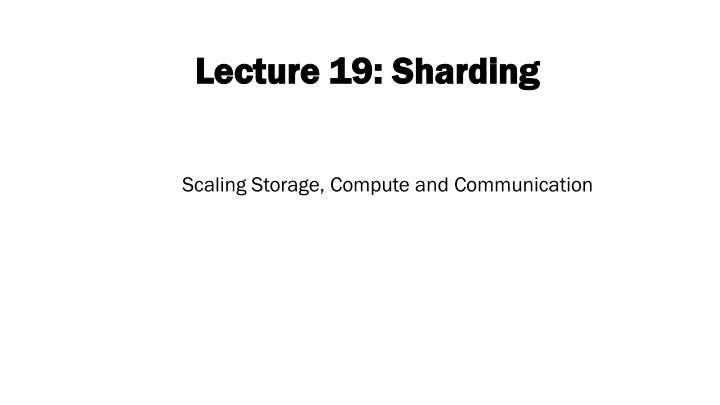
Sharding for Blockchain Scalability and Security
Explore the concept of sharding in blockchain technology, enabling scalability by distributing computing tasks and storage across network nodes. Sharding optimizes performance and resource utilization, balancing security and efficiency in decentralized systems.
Download Presentation

Please find below an Image/Link to download the presentation.
The content on the website is provided AS IS for your information and personal use only. It may not be sold, licensed, or shared on other websites without obtaining consent from the author. If you encounter any issues during the download, it is possible that the publisher has removed the file from their server.
You are allowed to download the files provided on this website for personal or commercial use, subject to the condition that they are used lawfully. All files are the property of their respective owners.
The content on the website is provided AS IS for your information and personal use only. It may not be sold, licensed, or shared on other websites without obtaining consent from the author.
E N D
Presentation Transcript
Lecture 19: Lecture 19: Sharding Sharding Scaling Storage, Compute and Communication
Thus Far Thus Far Bitcoin Last two lectures: PoW PoS eases burden of compute partially PoW Every node handles the full blockchain stores, computes, communicates Compute: mining, blockchain validation
This lecture: This lecture: Scaling Scaling Scaling compute, storage, communication Share burden across all nodes each node s requirement shrinks Ideal situation all resources are pooled together decentralized consensus but as if resources were centralized
Light Clients Light Clients Simple payment verification (SPV) Light client only maintains chain of headers minimal storage requirement Interested in validity of specific transactions requests Merkle proof of transaction inclusion depends on security of main chain for security of transaction buried deep in longest chain Light clients do not participate meaningfully (security) of blockchain
Blockchain Design: Replication Blockchain Design: Replication
Blockchain Design Thus Far Blockchain Design Thus Far Replication Increasing number of nodes (N) increased security no improvement on compute/storage/communication requirement per node every node computes, stores, communicates full blockchain
Independent Applications Independent Applications Many applications running on same blockchain parallel transaction ledgers example: each country runs its own ledger Idealistic scenario no interaction between ledgers/applications Run multiple blockchains Shards each node participates in only one shard
Basic Basic Sharding Sharding Nodes pick shard to participate lesser participants per shard Security limited adversaries can congregate in one shard Question node participate in only shard? can we get security from all participants, and yet each
Randomized Node Allocations Randomized Node Allocations Node-to-shard algo
Sortition Sortition Random assignment of nodes to shards adversaries cannot game the assignment Draw external common randomness multiparty computation (randhound) Draw randomness internal to blockchain sequence of miners on longest chain eligible for assignment hash value (PoW or PoS) determines which shard
Limitations Limitations Limitation 1: Identity management identity of participants needed for node-to-shard allocation public key is identity of nodes not truly permissionless Will address each limitation in upcoming lectures Limitation 2: Large size shards variance in sortition adversary fraction can be over-represented in a shard Limitation 3: Adaptive Adversaries nodes turn rogue after allocation
Intershard Intershard Thus far each shard independent ledger compute, storage, communication separate for each shard Question can this architecture be adapted to handle single ledger? Need to handle cross-shard transactions each shard maintains only its sub-ledger cross-shard transactions need careful attention
Cross shard transactions Cross shard transactions Alice: 10 Bob: 10 Alice->(Bob s receipt):5 (5 coins are destroyed From this shard s state) (Bob s receipt)->Bob:5 Alice: 5 Bob: 15 Alice wants to pay Bob 5 coins
Adversarial attacks Adversarial attacks Double spends Double spends Alice: 10 Bob: 10 Alice->(Bob s receipt):5 (Bob s receipt)->Bob:5 Bob: 15 Alice: 10
Atomicity Atomicity Multiple input transactions Alice+Bob pay Charlie Transaction state split across shards Alice in Shard A Bob in Shard B Charlie in Shard C Issue one shard commits, but the other aborts Alice s coin is spent, but Bob doesn t have enough funds
Summary Summary Intershard Consensus each node in a shard maintains full sub-ledger each node in a shard acts as light (SPV) client for other shards
Limitations Limitations Limitation 1: Identity management identity of participants needed for node-to-shard allocation public key is identity of nodes not truly permission-less Will address each limitation in upcoming lectures Limitation 2: Large size shards variance in sortition adversary fraction can be over-represented in a shard Limitation 3: Adaptive Adversaries nodes turn rogue after allocation
